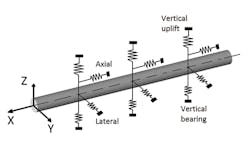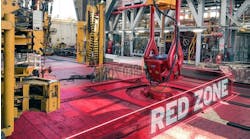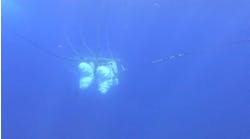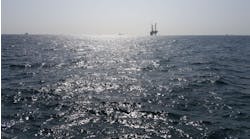Software solution provides seabed soil analysis, optimizes pipeline route
Samantha Langdeau
Bentley Systems
Extracting oil reserves from shallow waters in the Gulf of Mexico often requires placing new subsea pipelines to transport the crude oil efficiently and safely at a high pressure and temperature. Grupo Especializado en Obras Marinas (GEOMSA) is a major developer of pipe-soil systems in the Gulf of Mexico. With more than 18 years of experience in marine platform and submarine platform engineering projects, GEOMSA assesses the strength of subsea pipeline systems by determining the effect that expansion and lateral wear have on its life expectancy. The organization specializes in terrestrial pipe and industrial installation projects for hydrocarbon collection and processing. Recently, GEOMSA was tasked with assessing pipeline integrity under various conditions in the clay soil trenches of an underwater pipeline system.
The project’s objective was to increase domestic oil production in the surrounding region. The project team needed to determine how the new pipeline system would react to expansion and lateral deformation considering the route’s horizontal curves, the varying widths of the trench, the number of ocean floor levels above the pipeline, and how the pipeline would interact with the clay soil environment in which it was being placed. The team also had to determine a logical and reliable behavior of the pipeline by simulating it inside the trench considering variables such as temperature, lateral deformations, and system stress. Determining the characteristics of the trench allowed the design team to select the best materials to construct the system with the optimal pipeline route.
GEOMSA deployed AutoPIPE to calculate how the subsea pipelines would interact with the soil. (Courtesy Bentley)
Soil characteristics
To address these challenges, GEOMSA deployed AutoPIPE to perform the structural analysis and accurately model the geometry of the pipeline and the characteristics of the soil. The project occurred in two phases. In the first phase, the engineering team used AutoPIPE to develop a 3D model using the project’s informational database that describes the types of materials needed for the pipes, connections, and valves. The team could then select boundary conditions for the pipe above and below sea level.
In the second phase, the design team input codes and regulations, design factors, design pressure and temperature, and bend radius elbows. These factors were then used to calculate how the system would interact with the soil. The engineers manipulated the parameters of the soil-pipe interaction in the model to simulate the variations in the width of the trench. They also performed several flexibility analyses so that the team could obtain stress results and deformations in the clay soil.
“Bentley’s software provides engineering-friendly tools that allow us to model and analyze complex problems, like in this case soil-pipe interaction, and to obtain the structural behavior of submarine pipelines,” GEOMSA CEO Roberto Chávez Argüelles explained. “It helped us to make informative decisions about the recommended geometry of the pipeline and the minimum dimensions of the trench.”
Realistic designs
GEOMSA saw significant benefits by using AutoPIPE. The application helped the engineering team reduce the time that it would have normally taken to modify how the piping system would interact with the soil, while also accurately representing gradual variations in the trench’s width. AutoPIPE also enabled the engineering team to create realistic designs that reduced the risk of the pipeline failing. The user-friendly application displayed the analysis to the project team in a fully graphical environment so that the results could be clearly understood by all stakeholders. This improved collaboration, and saved time and cost. Bentley applications also helped the company continue its mission to reliably meet its clients’ requirements.
Other benefits provided by the software included reducing the amount of time it took to process the design analysis, delivery time, and costs, as well as automatically preparing a report of the results. AutoPIPE was also instrumental in allowing the project team to meet local and international regulations or codes. This allowed the team to automatically consider design code parameters for different load combinations to compare stresses and deformations. This capability allowed the engineers to feel confident that they were creating the safest pipeline system, reducing the risk of marine pipeline failure and the severe environmental impact on the surrounding area. Moreover, optimizing the volume of domestic oil production improves the country’s economy and helps create more jobs for the surrounding communities. •
Project summary
Organization: Grupo Especializado en Obras Marinas S.A.
Solution: Innovation in Offshore
Location: Campeche Bay, Gulf of Mexico, Mexico
Project objectives
• Implement a new pipeline system in the clay soil of the shallow Gulf of Mexico to transport oil reserves efficiently and safely
• Increase oil production in Mexico and create employment opportunities for the surrounding communities
Products Used:
AutoPIPE, SACS
Fast facts
• By performing a flexibility analysis, GEOMSA easily confirmed the wall thickness that the system required.
• The structural analysis helped establish accurate stress levels throughout the lifecycle of the system.
• AutoPIPE helped the team to comply with local and international codes.
ROI
• Bentley’s AutoPIPE allowed the project team to deliver more realistic designs, which improved system reliability and lessened the environmental impact.
• AutoPIPE reduced the analysis process, enabling GEOMSA to reduce delivery time and project costs.
• Optimizing the volume of domestic oil production improves the country’s economy and creates more local jobs.




